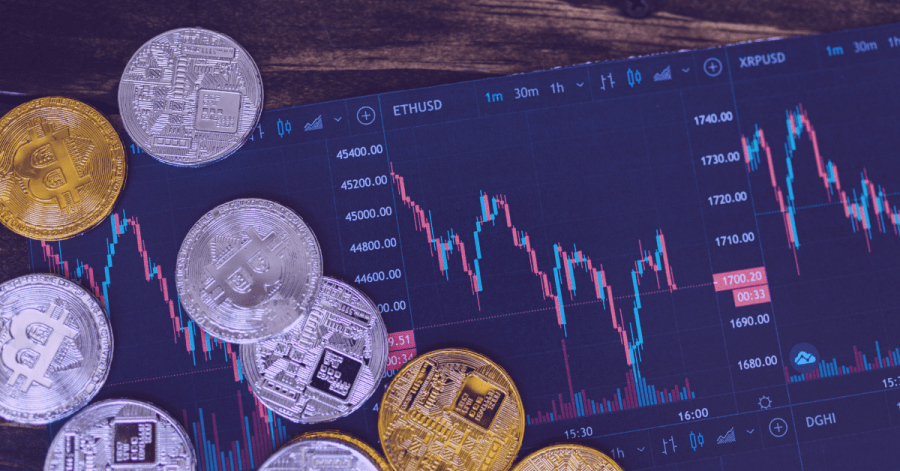The storm will wash us clean. This seems to be the general sentiment among market experts in Southeast Europe regarding the “crypto crash” – the recent slump in the global cryptocurrency market.
Sure, they all came at once. Bitcoin fell by more than half, dipping to its lowest point since late 2020. Coinbase, the largest cryptocurrency exchange, also reported losses of $430 million in the last quarter. Its stock price decreased by 82 percent since its debut in April 2021. And then there’s TerraUSD, the former third largest algorithmic stablecoin whose collapse reminded some of Lehman Brothers in 2008.
Terra’s sell-off partly drove an overall plunge of the crypto market to $1.28 trillion (value on May 19) from its $3.1 trillion peak in November 2021, and has since slightly recovered to $1.35 trillion (value on May 23), according to CoinGecko, a crypto market data aggregator. Add to that the geopolitical instability caused by the Russian invasion of Ukraine, surging inflation, and rising interest rates causing equity markets to slump, and you get the perfect storm that led to the crypto crash.
The Recursive reached out to cryptocurrency experts in Southeast Europe to understand the reasons behind TerraUSD’s crash, what lessons we can draw, and what comes next for crypto.
What led to the collapse of TerraUSD
In DeFi, stablecoins help investors convert their wealth in digital tokens, while limiting fear of crypto market crashes, by offering a collateral. If Bitcoin drops in value, for instance, an investor can exchange it for a stablecoin, which is pegged to the value of a fiat currency counterpart, such as the US dollar.
Yet because investors do not hold stablecoins for long, a second type has emerged that offers rewards for staking, i.e. holding onto the coins instead of selling them. Algorithmic stablecoins offer up to 20% profit for not moving your coins for a certain amount of time, buying and selling in order to balance the value of the coin around one US dollar.
“This was a ‘trap’ for small investors or late comers who would push their portfolios in these locked pools from which stablecoins pull their liquidity. That was one of the main reasons for the Terra ecosystem collapse. The reserves were depleted fast, handled by people who are techies, rather than financial wizards who understand stock exchanges and movements of the market,” Arvin Kamberi, Vice President of Bitcoin Association of Serbia, tells The Recursive.
TerraUSD (UST) is an algorithmic stablecoin traded on the Terra blockchain. It offers a complex combination of code, smart contracts, and trader incentives to keep its value pegged to the US dollar. Its sister coin LUNA is a crypto token, for which it can be swapped to keep the price of UST stable. Yet, these mechanisms eventually failed. Once the star of stablecoins, TerraUSD lost a historic $45 billion in value, ensuing a crypto crash.
This caused many ecosystem partners to drop their connections to Terra and former investors declining to participate in a subsequent financing call. Nexo, the Bulgarian-founded international crypto borrowing and exchange platform, for instance, delisted LUNA from the Nexo Exchange.
The greed for fame and fortune
Parallels between crypto markets and traditional finance have never rang louder, from recalling how greed, high leverage, and lack of regulation in shadow led up to the global financial crisis, to comparisons with speculative tech investment.
The collapse of Terra “highlights the volatility of the cryptocurrency market, which is struggling to stabilize because users are gambling instead of focusing on what cryptocurrencies should be: a currency used on a daily basis. As such, the abundance of cryptocurrencies (several thousand at the moment) is grotesque because it takes us away from the original idea of a single, reliable, universal (crypto)currency for all mankind,” shares Michael Lambert, political psychologist and cryptocurrency writer.
Algorithmic stablecoins, it turns out, present similar risks that we see in connection to bank runs. “I think it showed that crypto is susceptible to bank run almost the same as TradFi,” adds Vlaho Hrdalo, lawyer and Chairman of the Croatian Union for Blockchain and Cryptocurrencies (UBIK). To stop a bank run, banks may try to appear stable, hide information, or cause an artificial slowdown of the process.
Elsewhere in the market, Bitcoin reached its highest price correlation with US equities, prompting some to question whether the cryptocurrency can in fact provide the long-term value and resistance to economic trends that it once promised, or is in fact a high-risk investment.
This is something cryptocurrency detractors have long argued, and the current slump will strengthen these beliefs for many of them.
“Fear is the biggest factor currently driving the bearish sentiment we’re seeing in the crypto market. The neutral market sentiment has changed to negative recently, fueled by the Terra crash. In the end, price is a function of supply and demand – whenever people expect the prices to go down, they massively sell the assets, which leads to the prices going further down,” Irina Scarlat, Chief Growth Officer of Austrian unicorn investment platform Bitpanda, tells The Recursive.
From humility to choosing the right projects amid a bear market
The downfall of the Terra project can serve as a lesson to some of the biggest and everyday crypto investors, with the main point here being about modesty and humility when it comes to such a volatile market.
“What I think is important is that we all need to learn about being modest and humble. Dismissing dissenting opinions with “have fun staying poor” and similar is what turns you into those bankers that caused the 2008 recession and the entire blockchain story started because of bankers’ moral hazard and inconsiderate behaviors towards other people and other people’s property,” UBIK’s Hrdalo emphasizes.
While Terra wasn’t the first failed project that the crypto world has been through, it is among the first that could have dangerous outcomes, Hrdalo explains. For instance, some of the people who suffered huge losses even came to Terra’s CEO Do Kwon’s home and tried to break down his door. Kwon is also facing several lawsuits from investors in his native South Korea.
“This is the direct result of belittling others and showing disrespect. Crypto is very exciting and when the price of every token is surging, it’s easy to get carried away and think you are the smartest person in the world,” Hrdalo adds.
Another big lesson from the crypto crash would also be to choose the investment platform wisely: “The past few weeks have been chaotic in the crypto world, with bear market turbulence, stablecoin destabilization, and commotion around crypto-asset ownership. One major lesson that can be drawn: Where you buy your crypto really matters,” Irina Scalarlat tells The Recursive.
At the same time, the Terra crash can be an opportunity for those that are seeking the right projects to invest in and learn from this experience. As Hrdalo explains, the bear markets such as the current one are also best used for building quality projects and growing as a person and as an investor.
“Quality projects and people of virtue don’t disappear in the bear market, on the contrary – it becomes easier to find them. Because bull markets create an inflation of projects which makes finding worthy ones extremely difficult or as Mitch Kapor eloquently put it – like drinking water from the fire hydrant; there’s plenty of water but you’ll probably end up thirsty,” he tells The Recursive.
In the end, what the recent dynamics most likely show is that the crypto market is “under construction” – and there are still dodgy parts that we need to sort and remove in order to uncover the parts that will endure.
The importance of bitcoin for the crypto ecosystem is another key lesson for investors. Almost every market downturn so far has demonstrated that bitcoin performs more impressively over longer-time horizons and the best thing one can do is HODL (hold on for dear life) their digital assets because they deliver disproportionate returns, Hristiyan Hristov, Head of Institutional Client Management at Nexo points out, adding:
“Statistics show that despite Bitcoin’s recent price drop, funds posted inflows, which means investors took advantage of the lower price per coin. Bitcoin remains a good long-term inflation hedge and a store of value if not least because of the unprecedented interference of central banks and continued money printing that has poured $11.3 trillion dollars into the economy.”
How Bitcoin responded during the crypto crash shows that its volatility is actually decreasing: “While crypto has historically seen one or two moments like this per year, this time around we are noticing that the behavior has shifted — there was no major sell-off of crypto’s blue-chips. Nexo manages assets for four million retail clients and it’s clear that people have learnt their lessons from comparable events — the Covid crisis and the Chinese crypto ban — and are sticking to their holdings and even taking advantage of Bitcoin and other assets’ price declines,” Hristov shares.
Arvin Kamberi agrees, noting that one thing standing out for him was “the fact that Terra’s “security fund” that managed the treasury sold 80.000 BTC in order to keep the price around the one dollar peg. Yet this selling of the Bitcoin reserve did not influence the further decline of the BTC on stock exchanges. Bitcoin’s price is still around $30.000, it didn’t decrease too much. For me this is a strong indication that Bitcoin is slowing down its levels of volatility.”
What’s next for crypto: Diminished trust and higher call for regulation
While most investors were aware that the crypto ecosystem is a highly volatile environment, still there were those who pined most of their trust and hopes on projects such as Terra – and ultimately lost. Therefore, most of the trust that these investors had is now gone.
“The worst thing about Terra is that these people will lose faith and interest in blockchain altogether. Once lost, trust is difficult to regain,” Hrdalo says.
However, all is not lost after the crypto crash. In fact, crypto could come back even stronger.
“If we look backwards, despite massive volatility, we see an upward trending growth curve for digital assets. We do believe that this is going to keep happening, with the ups and downs that come along, and volatility is going to decrease as crypto enters the mainstream,” Irina Scarlat tells The Recursive.
In the long run, education and regulation are going to be crucial, especially given the market’s volatility. According to Scarlat, this could lead to all of the actors and stakeholders investing in educational initiatives around crypto. In turn, the potential regulation of the market can also bring confidence and inspire a decisive role when it comes to the adoption of blockchain technology.
“While the crypto world looks like Wild Wild West today, regulation is key and uniform regulation is necessary for crypto players to be able to develop and for regulators to be able to enforce, without discrimination, the same rules for everyone,” Scarlat adds.
Nexo’s Hristiyan Hristov also echoes the sentiment about regulation, arguing that recent developments regarding unregulated stablecoins have also prompted a response from regulators worldwide.
“Despite the pullback, net positives are coming out. One of them is the fact that US legislators are increasingly paying attention to the industry. Earlier this month, Treasury Secretary Janet Yellen called for stablecoin regulation and hinted that legislation could materialize before year-end. This is a telltale sign that crypto markets will continue to evolve and we expect them to become more sophisticated thanks to the emerging regulatory framework,” Hristov concludes.








